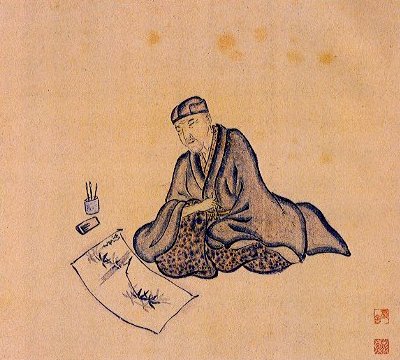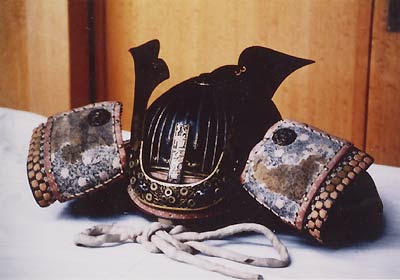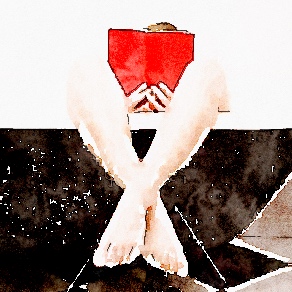I was reading one of Matsuo Basho’s travel diaries, The Narrow Road to the Deep North, last night. Those of you have been with me long enough, know that Basho is regarded as the greatest – the first, the last and the only 🙂 – haiku poet who ever lived. (Those of you haven’t been long enough can find links to an introduction to his poetry and to haiku poetry in general below.) Now haiku can be a bit cryptic sometimes, and I was delighted when I came across some of the Basho’s most famous haikus in his travel diary, accompanied by the stories or landscape that inspired them.

I’m sharing two of these today and maybe some others at a later time. Although neither of today’s haikus is difficult to understand or interpret, the story behind them might be of interest to those of you who like history!
The Cricket in the Helmet
so pitiful—
under the helmet,
a cricket
I think we had this particular haiku on the blog before, albeit in a different translation. This translation is by David Landis Barnhill.
Basho introduced the haiku in his travel diary with the following explanation:
In this area, I visited the Tada Shrine which contains Sanemori’s helmet and a piece of his armour brocade. In days of old, it is said, at a time when he still served the Genji clan, these articles were given to him by Lord Yoshitomo.
Certainly they were meant for no common warrior: from eye shield to ear flaps there is an engraved arabesque of chrysanthemum inlaid with gold and at the crown is a dragon’s head with the hoe-shaped crests attached.
In the annals of the shrine it is written that after Sanemori’s death in battle, Kiso Yoshinaka dedicated these relics to the shrine with a message of prayer; Higuchi no Jiro his emissary.
Here they lie before my eyes, just as in the legend.
It is remarkable, at least to my western eyes, that in the late 1600s Basho visited, in effect, a museum, where a precious piece of armour has been preserved from the civil wars of some five hundred years earlier. And of course, he knew the story behind it; but then he was a learned man.
Now I suspect that most of you are not that familiar of the early medieval history of Japan, so a little explanation about who Sanemori was, or indeed who the Genji were, and what civil war we’re even talking about. Some of it will be relevant also to the second haiku we will look at today.
The Genpei War
You probably all know that Japan has been ruled by emperors since time immemorial; however, for most of the time, the emperors’ rule was purely nominal and real power were held by the heads of various warrior clans (I expect the term shogun is familiar to all of you?).
Now back in the 12th century, three clans competed for power: the Fujiwaras, the Genji and the Heike. They were all descended from some earlier emperors, and eventually their contest for power resulted in repeated civil wars. (Just to confuse matters a little, the Genji are also known as Minamoto and the Heike as Taira; but bear with me.) The fight between these two – the Genji and the Heike – is knowns as the Genpei war, in the second half of the 12th century.
Their story is well known in Japan and provided literary inspiration to authors for centuries.
The Story of Sanemori

Saito Sanemori, in whose helmet the cricket was sitting, was originally a retainer of the Genji, whose then leader, Minamoto no Yoshitomo gifted him the armour; but he later changed sides. At the time of the battle of Shinohara, in 1183, Sanemori was seventy-three years old. He died his hair black to disguise his age and died in the battle, fighting for the Heike.
Warrior Dreams
summer grass—
all that remains
of warriors’ dreams
Again, we had this haiku before, although in a different translation.
And these were Basho’s thoughts and the scenery, where and when he penned the haiku:
The splendor of three generations is now but a dream; the ruins of the great gate lie one league off. All that remains of Fujiwara Hidehira’s castle are fields and paddies. Only Mount Kinkei retains its form.
First we climbed up Takadachi, Yoshitsune’s “high fortress”, and looking out we saw Kitakami, a large river flowing from Nambu Province. The river Koromo encircles the castle of Izumi Saburo and then below Takadachi it pours into the larger river. Beyond the Koromo Barrier is the ruins of the castle of Hidehira’s son, Yasuhira, which protected the approach from Nambu; it probably guarded against the Ezo tribesmen.
Yoshitsune’s retainers took this castle as their fortress; their glory, in a moment, has turned to grass. “A country torn apart, the mountains and rivers remain; in spring, in the ruined castle, the grass is green.”
I laid out my bamboo hat and I wept without sense of time.
The Story of Yoshitsune
Minamoto no Yoshitsune is the great tragic hero of the era and was always a particular favourite of mine.
He was the son of the aforementioned Lord Yoshitomo. When Yoshitomo was defeated in battle by the Heike in 1160, he was killed and many of his sons were executed outright.
Yoshitsune, then a babe in arms was spared but was separated from his mother and sent to live in a far off monastery. He escaped from there while still a teenager, and when his elder half-brother Yoritomo rebelled agains the Heike, he fought on his side in the Genpei war.
He was a legendary swordsman and an able general, winning several battles for Yoritomo, but after victory was hunted down by his brother and killed. He was only thirty at the time; it’s not known what became of his mistress and his son who was born posthumously. (There are a lot more details to this story but those would make a post in themselves!)
At the end of the war, Yoshitsune’s brother Yoritomo founded the Kamakura shogunate, the first shogunate in Japan, which lasted until 1333.
The line quoted by Basho towards the end, about the country torn apart, is from a Chinese poem, A Spring View by Du Fu (written in 735 AD).
Further reading:
⇒ An Evening with Matsuo Basho
⇒ Four Seasons in Japan - with Matsuo Basho
⇒ The Four Seasons in Japan
⇒ The Dark Side of Life (In Nine Haikus)
And more haikus in the following Lockdown Diary entries:
⇒ Day 36: Hiking the Kii Peninsula with a Book of Haikus
⇒ Day 42: Cherry Blossom Viewing
⇒ Day 48: Serenity
Picture credit for Sanemori's helmet: Picture by www.hot-ishikawa.jp retrieved via the blog post Daruma Pilgrim's Gallery (Fair Use) where you can also see a photo of the statue of Basho at the Tada Shrine!

